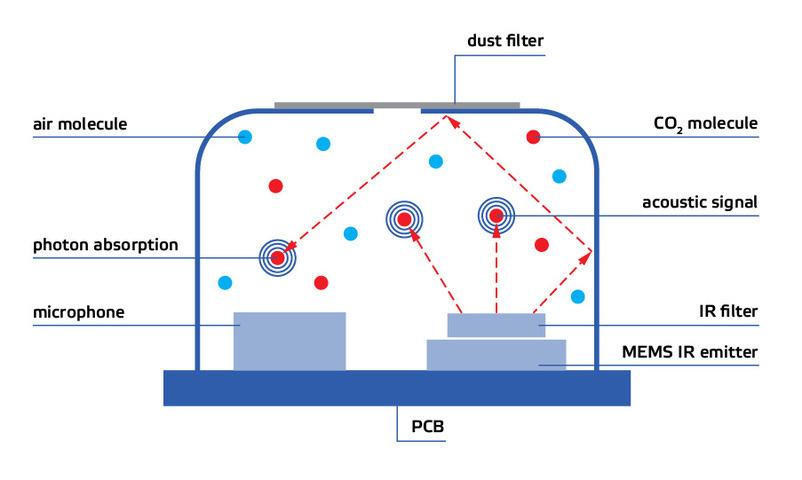What types of NDIR sensors exist?
General characteristics of all NDIR sensors
NDIR (Non-dispersive Infra-red) sensing has become the leading method for measuring CO2 concentration. This technology utilizes the strong absorption properties of CO2 molecules for infrared (IR) light at wavelengths around 4.2 µm. By shining light of this wavelength through a gas sample, the CO2 concentration can be determined based on the amount of light absorbed. The more CO2 molecules are present in the gas sample, the more IR light of this frequency is blocked (absorbed) by the CO2 molecules. The amount of IR light received with a wavelength of 4.2 µm is therefore a measure of the amount of CO2 in the air.
Only this target wavelength of the IR light is important for the CO2 measurement. A non-dispersive band-pass filter, allowing only the infra-red wavelengths of interest to pass ensures that the receiver sees only the IR light with the relevant frequency band. This technique is the basis of the naming: Non-dispersive Infra-red.
Transmissive NDIR

Transmissive NDIR sensors typically consist of an emitter of IR light and an optical detector, such as a photodiode, positioned at opposite ends of a specially designed optical cavity. The optical detector measures the IR light that is not absorbed by the gas sample. As CO2 concentration in the cavity increases, the detected light decreases. The difference between the measured light and a reference intensity at a known CO2 concentration is used to determine the absorbed light energy by CO2 molecules.
Transmissive NDIR CO2 sensors rely on IR absorption at the 4.2 µm wavelength without using dispersive optical elements. The accuracy of these measurements is highly dependent on the precise positioning of the IR emitter and photodetector, as well as the properties of the IR source and optical cavity. Mechanical and thermal stresses on the measurement chamber can significantly affect CO2 readings. Additionally, transmissive NDIR sensors typically require a minimum optical path length of several centimeters to ensure sufficient IR absorption for accurate measurement of lower CO2 concentrations. This is a limiting factor in making the sensors more compact.
Photoacoustic NDIR 

Unlike transmissive NDIR sensors, photoacoustic NDIR sensors measure the concentration of CO2 by detecting the sound waves produced when CO2 molecules absorb infrared (IR) light.
The IR light source is pulsed, meaning it turns on and off at regular intervals. This pulsing is crucial for generating the acoustic signal needed for detection. As the pulsed IR light passes through the gas sample in the measurement chamber, CO2 molecules absorb some of the light. This absorption depends on the CO2 concentration in the chamber.
When CO2 molecules absorb the IR light, they undergo molecular vibrations. This absorption process causes the molecules to heat up and expand. As the light source pulses, this heating and expansion occur periodically. The periodic heating and expansion of CO2 molecules create pressure waves or sound waves within the measurement chamber. Essentially, the pulsing light causes the gas to alternately expand and contract, generating an acoustic wave.
The sensor contains a sensitive microphone or acoustic detector within the measurement chamber. This microphone detects the pressure waves generated by the CO2 molecules. The amplitude of the acoustic waves is directly proportional to the amount of CO2 in the chamber.
Higher CO2 concentrations result in stronger absorption of IR light, leading to more significant molecular vibrations and, consequently, larger pressure waves. The acoustic signal detected by the microphone is processed by the sensor's electronics. The signal's amplitude is analyzed to determine the CO2 concentration. Advanced algorithms are used to filter out noise and ensure accurate measurements.
Photoacoustic NDIR sensors can be made smaller than traditional transmissive NDIR sensors because they do not require a long optical path for accurate measurements. This makes them suitable for applications where space is limited.
The sensor's design is less sensitive to the precise alignment of optical components. Sound waves are omnidirectional, meaning the relative positioning of the IR emitter and the microphone is not as critical. This makes photoacoustic sensors more robust to mechanical and thermal stresses. They can be highly sensitive to small changes in CO2 concentration, providing accurate readings even at low concentrations.
Further reading: Learn more about the different types of NDIR sensing technologies in this review paper by D. Popa and F. Udrea of the University of Cambridge
